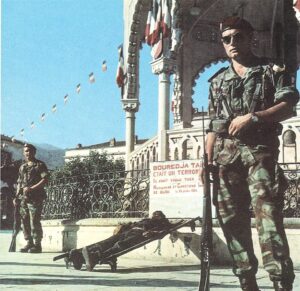Introduction to Place Ettoute
Place Ettoute, also known as Plassat Tout, is one of the most iconic landmarks in Blida, Algeria. Located in the heart of the city, this historic square blends centuries-old heritage with a lively modern atmosphere. From its Moorish-style kiosk to its surrounding cafés and gardens, Place Ettoute is a must-visit for travelers, history lovers, and anyone looking to experience the authentic spirit of Blida.
Location & Surroundings
Situated at the southwest end of the city’s main boulevard, Place Ettoute is surrounded by key landmarks:
- Bab Essebt (north)
- Kawther Mosque and Bab Errahba (south)
- Rue d’Alger and Bab Edzair (east)
- Lycée Ibn Rochd and Bizot Garden (west)
Its central location makes it an ideal starting point for exploring Blida’s historic gates, markets, and gardens.
The Moorish-Style Kiosk – A Symbol of Blida
At the square’s center stands a white Moorish-style kiosk, an emblem of the city’s charm. The area is pedestrianized, perfect for relaxing strolls. Around the square, visitors can enjoy traditional coffee houses and famous ice cream shops, including:
Siksico
Andalusia Coffee
Qahwat Challane
Origin of the Name “Ettoute”
Two main theories explain the name:
- From Administration Buildings – A shortened form of “Place de toutes les administrations” (Square of All Administrations) from the colonial period.
- From Mulberry Trees – In Algerian Arabic, tout means mulberry tree. In the 1980s, mulberry trees were planted here, replacing older plane trees.
Historical Significance
Place Ettoute is more than a public square—it’s where Blida’s history began.
- In the 1530s, Sid Ahmed el Kebir, founder of Blida, built the city’s first mosque (Djemaa Sidi el Kebir), along with a hammam and a communal bakery on this very site.
- Under French colonial rule, the square changed names several times: Place d’Armes, Place Clemenceau, Place du Kiosque. It was used for military parades, public gatherings, and celebrations. El WATAN Article

Timeline of Key Events
| Year | Event |
|---|---|
| 1867 | Temporary tents were set up after an earthquake to shelter residents. |
| 1870–1871 | French soldiers played jeu de Paume here; the city built a water basin to stop the games. A mulberry tree was planted, later replaced by a poplar and then a symbolic palm tree (“Tree of Liberty”). |
| 1910 | Wooden Andalusian-style kiosk built around the palm tree. |
| 1947 | Sirocco winds damaged the palm tree; several replacements followed. |
| 2000 | Mayor Hafsi renovated the kiosk, adding a circular rose garden. |
| 2017 | Major restoration included the fountain, landscaping, and green spaces. |
Place Ettoute Today
Now officially called Place du 1er Novembre 1954, the square remains a cultural hub of Blida. It is a favorite gathering spot for residents and visitors alike, offering:
- Open-air seating in historic cafés
- Artisan ice cream and pastries
- Proximity to cultural sites
- Seasonal events like the Battle of Flowers parade
The Kawther Mosque provides a stunning backdrop, adding to the square’s spiritual and architectural charm.
Why Visit Place Ettoute?
- Historical Value – The birthplace of Blida’s urban life.
- Architecture – Beautiful Moorish-inspired kiosk and surrounding heritage buildings.
- Atmosphere – A lively mix of tradition, leisure, and local culture.
- Accessibility – Centrally located, easy to explore on foot.
Travel Tips
- Best Time to Visit – Late afternoon for the golden light and cooler temperatures.
- Nearby Attractions – Bizot Garden, Blida Souk, Bab Errahba.